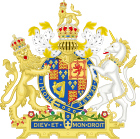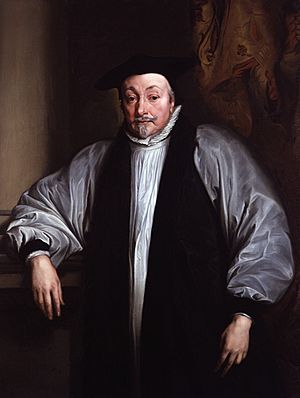Clergy Act 1640 facts for kids
| Act of Parliament | |

|
|
| Long title | An Act for disabling all persons in Holy Orders to exercise any temporal jurisdiction or authority . |
|---|---|
| Citation | 16 Cha. 1. c. 27 |
| Territorial extent | Kingdom of England |
| Dates | |
| Royal assent | 14 February 1642 |
| Commencement | 15 February 1642 |
| Repealed | 30 July 1661 |
| Other legislation | |
| Repealed by | Clergy Act 1661 |
|
Status: Repealed
|
|
| Text of statute as originally enacted | |
The Clergy Act 1640 was an important law in England. It was also known as the Bishops Exclusion Act or the Clerical Disabilities Act. This law became active on February 13, 1642.
Before this Act, bishops from the Church of England were members of the House of Lords. They made up a big part of the Lords, about 22 out of 60-70 members. This allowed them to stop new laws proposed by the Commons. The Commons was increasingly led by a group called Puritans.
Puritans were people who wanted to 'purify' or change the Church of England. They had different ideas but generally did not like bishops. They had both religious and political reasons for this. Even some moderate people, like Viscount Falkland, noted how strong these feelings were.
The House of Lords was later removed in 1649. It came back in 1660, but bishops were not allowed back until the Clergy Act 1661.
Why the Clergy Act Was Needed

In 1642, most English people believed in a king-led country. But they disagreed on how the king should rule. They also argued about who should control the church.
People called Royalists generally supported the king. They believed the Church of England should be run by bishops. These bishops were chosen by the king and answered to him.
On the other hand, Parliamentarians had different ideas. Many of them were Puritans. They believed the king should answer to church leaders, or Elders. These elders were chosen by their church groups.
Puritans wanted to reform the Church of England. They included groups like Presbyterians and Congregationalists. Presbyterians were very strong in Parliament. Leaders like John Pym and John Hampden were Presbyterians.
Religion and politics were closely linked back then. One big reason people opposed bishops was their power in the House of Lords. Bishops often blocked laws that Parliament wanted to pass.
How the Act Was Passed
In 1629, King Charles I closed Parliament. This started a time known as Personal Rule. During this time, the king ruled without Parliament. He used special taxes, like Ship money, which many people disliked.
Changes to the Church of England also caused problems. Archbishop Laud made these changes. Many people thought his changes were too much like Roman Catholic ideas. Many church leaders also opposed him. One historian even called Laud "the greatest calamity" for the English Church.
King Charles tried to make similar changes in Scotland. This led to wars in 1639 and 1640, called the Bishops' Wars. Charles did not want to call Parliament to get money. This made his army weak. Scotland won, and their church removed bishops.
The Long Parliament met in November 1640. It received a request called the Root and Branch petition. This petition was signed by 15,000 people from London. It asked for bishops to be removed from the Church of England. This showed how much people disliked bishops.
At first, Parliament did not pass this petition. But Laud was arrested and held in the Tower of London. In early 1641, Parliament passed new laws. These laws included the Triennial Acts, which made sure Parliament met regularly. They also ended the Star Chamber and stopped the king from raising taxes without Parliament's approval.
However, the bishops in the House of Lords rejected all three of these new laws.
In response, Parliament proposed the Bishops Exclusion Bill in June. This bill aimed to remove bishops from the House of Lords. But the Lords rejected it again.
Things got more heated when the Irish Rebellion started in October 1641. In December, there were big riots in Westminster. These riots were led by young apprentices from London. Some people died during these events. It is thought that some Parliament leaders might have helped organize these riots. One result was that bishops could not attend the Lords.
On December 30, Archbishop John Williams and eleven other bishops signed a complaint. They said that any laws passed by the Lords while they were excluded were not legal. Parliament saw this as an attempt to get King Charles to close Parliament. So, all twelve bishops were arrested on serious charges.
When King Charles left London in January, many Royalist members of Parliament and the Lords went with him. This gave his opponents a majority in both houses. Because of this, the bill to remove bishops became law in February 1642.
What the Act Did
The Clergy Act 1640 stopped people in holy orders (like bishops) from holding any government or legal power. This meant they could not sit in Parliament or on the Privy Council. Any actions they took with such power after February 5, 1641 (Old Style calendar) were considered invalid.
In 1649, the House of Lords was abolished by the Protectorate government. It was brought back when King Charles II returned in 1660. However, bishops were not allowed back into the House of Lords until the Clergy Act 1661 was passed.

